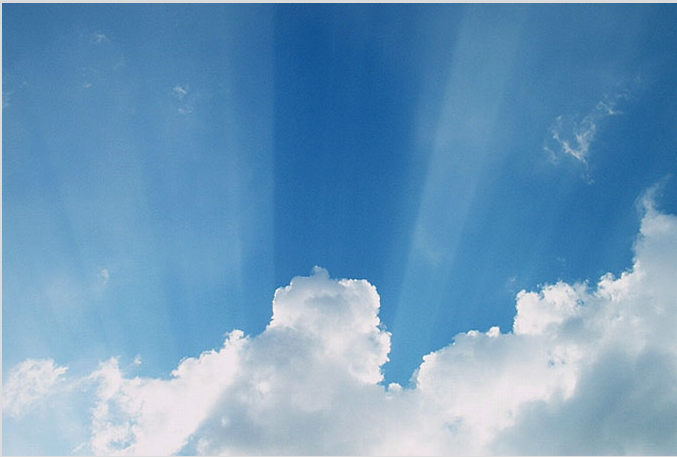Crepuscular rays
Crepuscular Rays: Nature's Spectacular Light Show
Crepuscular rays, also known as sunbeams or god rays, are a mesmerizing atmospheric optical phenomenon that occurs when sunlight is scattered by dust, water droplets, or other particles in the atmosphere. These rays appear to radiate from the point in the sky where the sun is located and can be seen during sunrise or sunset when the sun is low on the horizon. While they may seem like beams of light shooting upwards, they are actually parallel and slanting downwards due to perspective effects.
How Crepuscular Rays Form
The formation of crepuscular rays begins with sunlight passing through gaps or breaks in clouds or other obstructions on the horizon. As the sunlight interacts with atmospheric particles, it scatters in all directions. However, the scattering is more prominent in the forward direction, creating a cone-like pattern of light that appears to converge towards the sun. This convergence gives rise to the visually striking effect of crepuscular rays.
The Role of Perspective
One of the fascinating aspects of crepuscular rays is their apparent upward direction. This illusion occurs due to perspective effects. When we observe these rays from the ground, they appear to fan out and beam upwards. However, if we were to extend these rays beyond our viewpoint, they would continue to slant downwards and eventually reach the ground. It's important to note that this illusion is purely a result of our perspective and does not reflect the actual path of the rays.
Atmospheric Conditions for Crepuscular Rays
To witness the enchanting display of crepuscular rays, certain atmospheric conditions must align. Firstly, there needs to be a source of illumination such as the sun, positioned at a low angle relative to the observer. Secondly, there must be an obstruction or medium through which the sunlight can scatter, such as clouds, trees, or mountains. Finally, the presence of airborne particles, such as dust or water droplets, is crucial for the scattering process to occur.
Variations in Crepuscular Rays
While crepuscular rays typically appear as bright beams of light against a dark background, they can vary in appearance depending on atmospheric conditions and the observer's position. Here are some notable variations:
-
Anticrepuscular Rays: These rays appear on the opposite side of the sky from the sun. They are a mirror image of crepuscular rays and can be seen during sunrise or sunset when the observer is facing away from the sun.
-
Brocken Spectre: This optical phenomenon occurs when an observer's shadow is cast onto clouds or fog below, creating a circular halo with the observer's head at the center. Crepuscular rays often accompany this captivating sight.
-
Cloud Shadows: When crepuscular rays interact with clouds, they can cast shadows that appear as dark patches amidst the bright beams of light. These cloud shadows add depth and complexity to the overall visual spectacle.
Cultural Significance and Interpretations
Crepuscular rays have captivated humans throughout history, inspiring various interpretations and cultural significance. Across different cultures and religions, these rays have been associated with spiritual or divine messages, symbolizing pathways to heaven or acts of celestial beings. They have also been depicted in art, literature, and religious texts as a representation of beauty, enlightenment, and hope.
Capturing the Magic: Photographing Crepuscular Rays
Photographing crepuscular rays can be a rewarding experience, allowing you to capture the ephemeral beauty of this natural phenomenon. To enhance your chances of capturing stunning images, consider these tips:
-
Timing: Plan your photography session during sunrise or sunset when the sun is low on the horizon, creating optimal conditions for crepuscular rays to form.
-
Composition: Look for interesting foreground elements such as trees, mountains, or buildings to add depth and context to your photographs.
-
Exposure: Experiment with different exposure settings to balance the brightness of the rays with the surrounding landscape. Bracketing your shots can help capture the full dynamic range of the scene.
-
Post-processing: Fine-tune your images during post-processing to enhance the contrast, colors, and overall visual impact of the crepuscular rays.
Unveiling Nature's Mysteries
Crepuscular rays are a breathtaking testament to the wonders of our atmosphere. From their formation through scattering to the illusions created by perspective, these rays continue to fascinate and inspire us. Whether you witness them in person or capture their beauty through photography, crepuscular rays remind us of the intricate and awe-inspiring phenomena that occur in the skies above us. So, next time you find yourself at sunrise or sunset, take a moment to look up and witness nature's mesmerizing light show.

Upward rays? Imaged by Carolina Odman at Cambridge, England 28th July 2002. Perspective effects make the rays appear to beam upwards and spread apart. They are actually all parallel and slant downwards, if sufficiently extended they would pass over the camera and reach the ground beyond it. Image ©Carolina Odman , reproduced with permission.
Note: this article has been automatically converted from the old site and may not appear as intended. You can find the original article here.
Reference Atmospheric Optics
If you use any of the definitions, information, or data presented on Atmospheric Optics, please copy the link or reference below to properly credit us as the reference source. Thank you!
-
<a href="https://atoptics.co.uk/blog/crepuscular-rays-2/">Crepuscular rays </a>
-
"Crepuscular rays ". Atmospheric Optics. Accessed on November 22, 2024. https://atoptics.co.uk/blog/crepuscular-rays-2/.
-
"Crepuscular rays ". Atmospheric Optics, https://atoptics.co.uk/blog/crepuscular-rays-2/. Accessed 22 November, 2024
-
Crepuscular rays . Atmospheric Optics. Retrieved from https://atoptics.co.uk/blog/crepuscular-rays-2/.